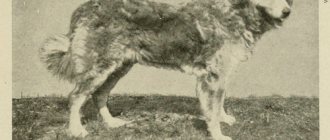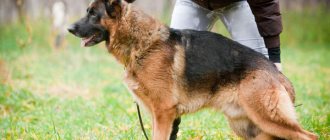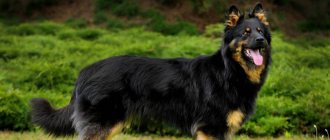To a layman's eye, the German Shepherd and the East European Shepherd are so similar that they appear to be the same breed.
But, despite the external similarity and common origin, these dogs are completely different both in their character and temperament, and in their service use.
And externally, if you look closely, the “German” and the “Eastern” are not so similar.
Which of them is better and who is better to have as a friend and guard?
Let's find out everything in the article.
Briefly about the German Shepherd
Description of the breed
This is one of the most famous dog breeds in the world, if not the most famous. Despite the fact that the original purpose of German Shepherds was to herd livestock, the characteristics of their character and temperament made these dogs suitable for any service.
“Germans” not only serve in the army and police, but also work as rescue dogs or guides for the blind.
German Shepherds also go in for sports, and they can master any kind of sports. And, of course, German shepherds are wonderful guards and bodyguards.
It is not surprising that all over the world these dogs are most often chosen as guards for private houses and city apartments. After all, the endurance and unpretentiousness of shepherd dogs make them suitable for living in a wide variety of climatic conditions.
The German Shepherd is large in size: it is 50-65 cm, and its weight can reach 30-50 kg .
Her body format is somewhat stretched out, but at the same time the dog looks harmonious and not too squat. The length of the head is approximately equal to 40% of the height at the withers, while the skull and muzzle are equal in length.
From above, the head resembles a wedge: wide at the top, it tapers towards the nose. The ears of the German Shepherd are not very large, erect, in the shape of a triangle with a wide base.
The eyes are oval, the look is intelligent and alert. The nose is quite large and black. The neck is strong, strong and muscular. The withers are well defined, the line of the back is even, slightly lowered.
The croup slopes down and meets the base of a saber-shaped, slightly curved tail . The forelimbs are smooth and straight, the hind limbs are strong and muscular.
The color can be black, dark or light gray, black and tan, zoned, saddleback, and also red of various shades. White German Shepherds are also bred in America, but this color is not recognized in Russia.
The German Shepherd can have both coarse and relatively short hair, and longer, forming fringes on the ears, limbs and tail..
Advantages and disadvantages
pros:
- Smart and easy to train.
- He is distinguished by exceptional devotion.
- Unpretentious - easy to maintain.
- They treat children well.
- They are able to distinguish a “work” situation from an everyday one.
- Well guarded.
- A versatile service dog suitable for any job or sport.
Minuses:
- It is necessary to seriously engage in training.
- The German Shepherd needs a lot of physical exercise.
- Not a lap dog, but a working dog who should have his own business.
- May show excessive aggression if improperly raised.
- Dogs of this breed can be hyperactive.
- Nervous breakdowns are possible during overtraining.
Character
The German Shepherd is an attentive, obedient and incorruptible service dog known for its courage and determination.
Quite angry and distrustful of strangers, at the command of the owner she is ready to attack the intruder at any moment.
At home, she is calm and friendly towards the owner and members of his family.
Briefly about the East European Shepherd
The East European Shepherd was bred on the basis of the German Shepherd breed in the 20-30s of the 20th century.
When creating the “Easterns,” the main goal was to breed the ideal dog for service in the army and law enforcement agencies, which is why the emphasis was placed on large stature, endurance and physical strength, for which the dogs were crossed with huskies and some breeds of mastiffs.
As a separate breed, the East European Shepherd was recognized only in 1976, despite the fact that already around the 1930s, mainly dogs of this type were bred in the country.
The East European Shepherd is a large dog, whose height is 62-76 cm at the withers. In terms of the shape of the head and general proportions of the body, it is not much different from the German Shepherd, except for the fact that the “German” has a pronounced back, while the “Eastern” has a straight back.
The coat is dense, hard, and medium in length. The undercoat is shorter than the spine and well developed.
The most preferred colors: black and black . Zone-gray and zone-red are allowed by the standard, but are not very desirable.
Advantages and disadvantages
pros:
- Calm and balanced.
- Smart and understanding.
- Differs in devotion to owners.
- Understands when it is time to stop pursuing the offender and return to the owner.
- Patronizing towards children.
- An excellent security guard and watchman.
- Even an elderly person or a teenager can cope with her training.
- Doesn't get into a rage while working, but carries out commands with maximum concentration.
Minuses:
- Serious training is required.
- She may be overly distrustful of strangers.
- Not universal.
- Puppies of this breed are more difficult to raise due to their large size and accelerated growth.
- Sometimes they are very stubborn.
- They like to show independence.
Character
East European Shepherds are calm and balanced. They take their work seriously and responsibly. These dogs have a strong protective instinct, which makes them excellent watchdogs.
Very intelligent and have an excellent memory, just like Belgian Shepherds.
During training and professional use, problems can only arise due to their stubbornness and excessive independence.
Children are treated patronizingly.
They do not harm other people's dogs and other animals, unless they themselves annoy them..
History of breeds: who was first - Germans or Russians
VEO
German Shepherd.
Which is better: Eastern European or German Shepherd? Eastern European
32.22%
German
13.33%
Both are great
54.44%
The East European Shepherd and the German Shepherd are historically related. Without one breed the other would not exist.
German Shepherds (GSDs) are relatively young dogs. The breed was bred by breeder Max von Stefanitz, and the first male German Greif was presented at an exhibition in 1882. However, according to another version, a dog named Hector performed in the ring 3 years earlier.
At first, NOs were used to escort and protect herds. But when pastures shrank and the number of farmers decreased, new uses were found for the pets. They were “retrained” for service in law enforcement agencies.
Today, NO is used in the army, police, border service, and rescue and search structures. These are hardy dogs with an excellent scent, impeccable obedience and remarkable strength.
These qualities of German dogs seduced Soviet military personnel. The first representatives of non-profit organizations came to the USSR at the beginning of the 20th century. However, they are poorly adapted to the harsh weather of Russia. In addition, the security forces of the Soviet Union needed a larger and stronger dog that would detain criminals and escort prisoners.
Although the two breeds are close relatives, VEO breeders have achieved differences. Eastern European dogs are larger, more powerful, tougher and calmer than their counterparts.
In the 30s selection began. To create a super service dog, breeding dogs of the German Shepherd breed were selected from kennels in Germany. Large representatives were bred, with height and weight at the upper limits of the standard.
As a result of the culling, East European Shepherds appeared - the pride of dog handlers in the Soviet Union. They were recognized in 1964.
What are the differences?
East European Shepherds are larger and more massive than German ones: their height is about 10 cm greater. But the main external difference between these two breeds is their structure.
If the “German” has a back inclined from the withers to the base of the tail, then the “Eastern” has practically no slope.
In addition, the front limbs of the German Shepherd are longer than the hind limbs, while the Eastern European has all the legs of approximately the same length.
The type of movement is another external difference.
“Germans” move at a measured and free trot, and “Easterners” move at a sweeping and fast gait.
These breeds also differ in temperament: German shepherds are choleric, while Eastern European dogs are phlegmatic. And, if the former are distinguished by impetuosity and speed of reaction to an immediate threat, then the latter are calm and unperturbed.
German Shepherds act impulsively when detained and, if they get into a rage, it can be difficult to stop them.
The East European Shepherd acts deliberately and carefully: it monitors the actions of the detainee and therefore it is not easy to take him by surprise.
“Germans” are a universal breed, but “Easterns”, originally bred for protection, are mainly used as watchdogs.
Appearance and color
The key external difference between the German Shepherd and the Eastern European is the back. If the first one bends in a small arc, then the second one is straight. Interestingly, female East European Shepherds are much larger than males. You can distinguish one variety from another if you observe for some time the peculiarities of the dogs’ movement. For example, the “German” in running is somewhat reminiscent of a trot.
Similar article: How pregnancy and childbirth go in a German Shepherd
The Eastern European equivalent of this breed has a sweeping run. The difference between the East European Shepherd and the German Shepherd is not always visible in color. Both one species and the other can have both black and zoned shades of coat. If you want to see clear differences between breeds, don't rely on color. Better pay attention to the structure of the skeleton, features of behavior and movement.
How are they similar?
- Both of these shepherds are smart, quick-witted and highly trainable.
- They both have a protective instinct by nature.
- Both the “German” and the “Eastern” are able to sense the mood of the owner and act in accordance with it.
- Both breeds are distinguished by strength, endurance, courage and viciousness, as well as distrust of strangers.
- Both dogs are unpretentious to living conditions.
NOTE!
With proper training, both the “German” and the “Eastern” make wonderful working dogs: loyal, reliable and hardy.
Which breed is best suited for living in an apartment?
A German Shepherd is more suitable for apartment living, since a more powerful and heavier “Eastern” dog will be uncomfortable in an apartment.
It is recommended to keep such a dog as a guard for a private home.
Expert opinion
Kozhevin Semyon Kirillovich
Expert dog handler.
“When deciding who is better to get - a German or East European shepherd, you need, first of all, to focus on the purpose and temperament of these dogs. The German Shepherd is more active and impulsive, while the Veo is calm and balanced. Representatives of both breeds can guard the house, but the “German” is more suitable for apartment maintenance. If we are talking about buying a future exhibition champion or winner of a sports competition, then, of course, you need to get a German shepherd.”
History of the origin of breeds
The German Shepherd was bred in the Scandinavian countries at the end of the 19th century. This breed quickly became widespread throughout Europe. At first, the “Germans” were bred exclusively for shepherding.
But over time, the advantages of this species made it possible to successfully use these dogs in the service and investigative field. Even taking into account the emergence of dozens of new breeds in recent years, no one has yet managed to surpass German shepherds in this activity. As for East European Shepherds (VEO), this variety was created by domestic breeders, but already at the beginning of the 20th century. The thing is that the “Germans” had a hard time enduring the harsh winters in the Far North and the heat in the East. That is why it was necessary to develop a breed that could better maintain performance even in “Spartan” conditions. This is exactly how the Eastern European variety of service dogs was created.
Who is easier to maintain and care for?
Caring for the “German” and the “Eastern” is almost the same: both dogs need regular brushing (3-4 times a week, and daily during shedding).
They also need to clean their eyes and ears if necessary, and in order to clean their teeth, give them special chewing toys . Nails should only be trimmed if they do not wear down on their own.
Representatives of both breeds are bathed no more than once every 2-3 months.
How are these breeds similar?
The similarities between German and Eastern European animals lie in three factors:
- identical roots. Due to the history of selection;
- coat color. There are black, black and tan coats. The appearance is attractive and unique;
- character and easy to learn. Some representatives of these breeds are honored heroes of the country and have a huge number of medals. Firefighting, police, marine, and military dogs are known.
Dogs often become man's best friends, guardians of home plots. They are friends with children and try to protect little people from various dangers. The Internet is full of videos where representatives of both breeds perform their purpose efficiently.
Attitude towards children and pets
The German Shepherd treats children as equal playmates, but at the same time does not particularly like their pestering and does not tolerate being annoyed. The East European Shepherd treats children patronizingly: it takes care of and protects them.
Representatives of these breeds treat pets differently.
The “Germans” try not to offend cats unless they offend them themselves. Other dogs are only tolerated, and small animals are treated as potential prey.
“Easterners” are calmer and treat any other animals quite loyally.
In order for the dog to treat other pets normally, you need to introduce the puppy to them as early as possible, without allowing conflicts..
What role do these breeds play in modern society?
The most popular dogs are representatives of the German breed. Dog handlers try to monitor their existence and keep it at a high level. This way they confirm the high status and prestige of the “German club”. People are willing to buy puppies. Finding a purebred representative with a decent pedigree is not difficult.
Representatives of VEO are not very common in the world. They are found in countries that once belonged to the USSR. Zoologists, dog handlers, and ordinary people try to support this club. According to experts, Eastern European dogs suffer from degeneration. It is very difficult to find a purebred puppy that meets all breed standards. The cost of the noble line is quite high, and not everyone can afford to purchase such a pet.
Who is more picky about feeding?
The German Shepherd can be fed with ready-made high-quality food no lower than premium. These dogs can also eat natural food based on animal protein products.
Experts recommend feeding the East European Shepherd with natural food..
Due to the fact that such large dogs have problems with the musculoskeletal system during periods of active growth or in old age, you need to give them enough soft cartilage and add drugs with chondroprotectors to their food, which the veterinarian will recommend.
What is the difference between a German puppy and an Eastern European one?
Babies can be distinguished by a characteristic feature - the line of the back. In Germans it is slightly inclined towards the tail, in Eastern Europeans there is a perfectly straight line between the withers and croup. Second babies are born larger and are able to gain weight faster. Easterners are slower and clumsier.
Important! It is impossible to predict which purebred dog will become the future champion. Puppies of different classes are born in a litter.
East European Shepherd puppies
Other criteria
Activity
German Shepherds are much more active than the calmer Eastern European dogs, who are more interested in their immediate work than in participating in family games.
Trusting strangers
Representatives of both breeds are distrustful of strangers, but with proper upbringing they restrain themselves from showing aggression until they receive an order from the owner to attack.
Lifespan
East European Shepherds live 12-16 years, and the lifespan of a “German” is 10-14 years.
Devotion
Both breeds are distinguished by exceptional devotion to their owner. But the East European Shepherd is more likely to bond with one person, while the German will willingly work with anyone who gives him the opportunity to use his working skills.
Training
“German” treats training as a game, and “Eastern” - as real work, for which there should be encouragement.
Which breed should you choose?
When deciding who, after all, to get - a “German” or an “Eastern”, you need to focus on the purpose of the pet and the conditions of detention.
IMPORTANT!
For people living in a city apartment, their choice should be a German shepherd, since the Eastern European is not suitable for apartment living due to its large size and the fact that this dog needs a large living space.
And those who live in a private house need to decide who is more suitable for them in terms of temperament and character traits: an energetic and very active “German” or a calm, reasonable and imperturbable “Oriental”.
The German and East European Shepherd are related breeds, but there are many differences between them . First of all, they relate to character traits, temperament and official use.
The German Shepherd is a universal service dog, suitable for any job, while the “Eastern” is more focused on guard duty. He is more balanced and not as mobile as the “German”, who constantly needs to be at work, to be on the move.
It is also important to take into account that the German Shepherd is valued as a show dog, while “Easterns” are bred mainly from working lines.











